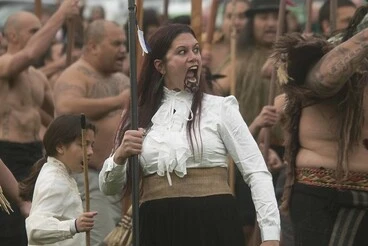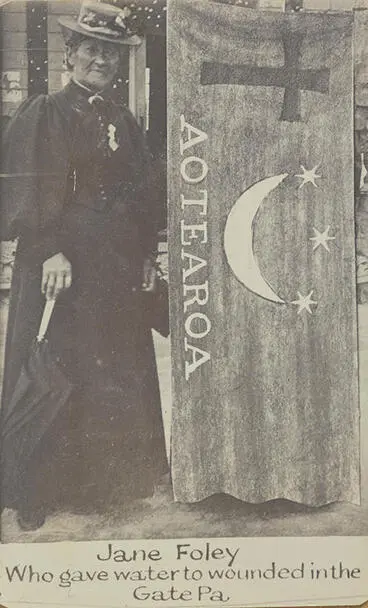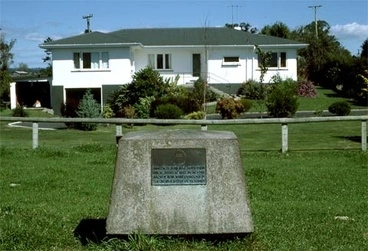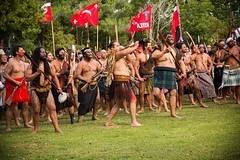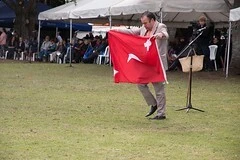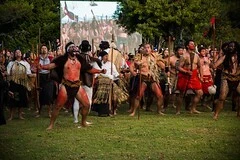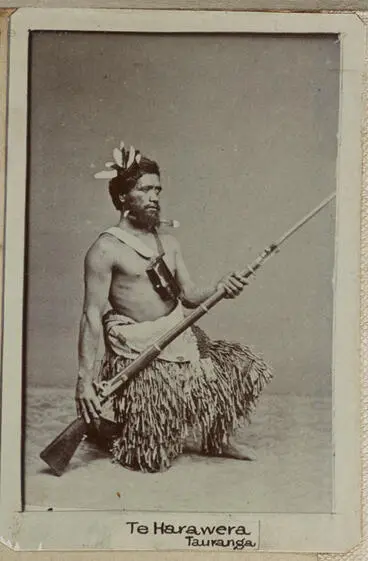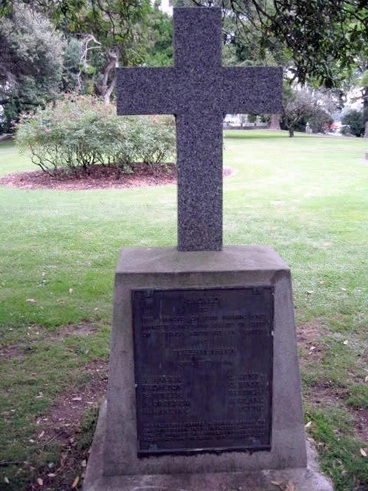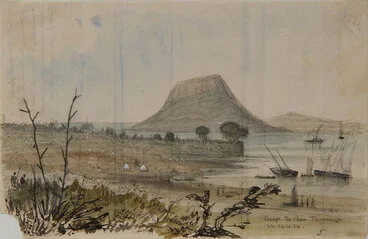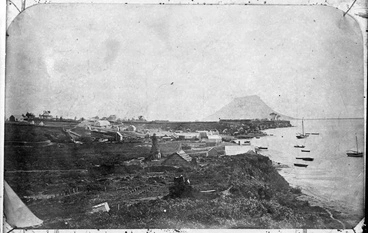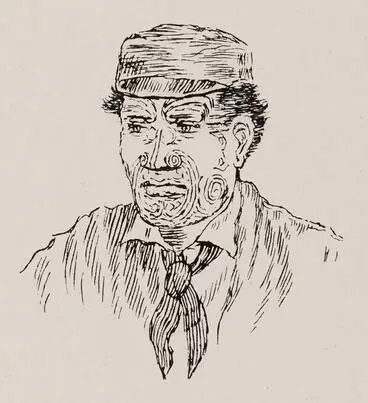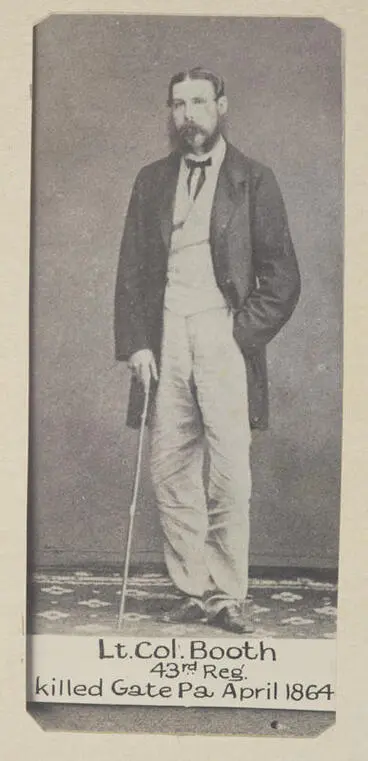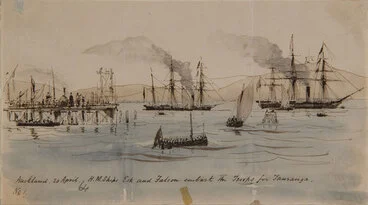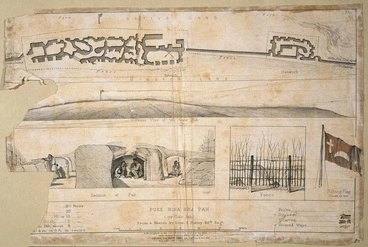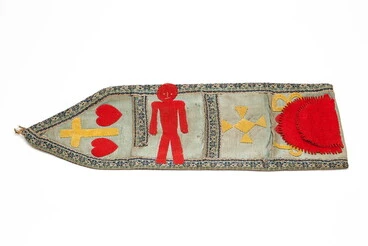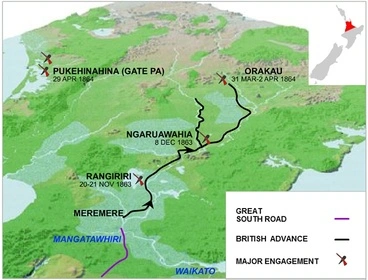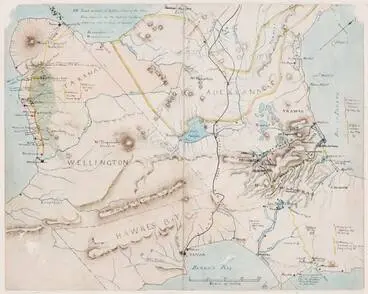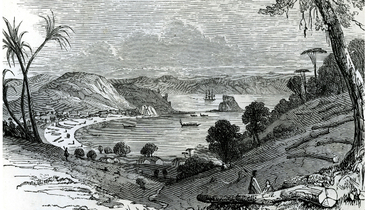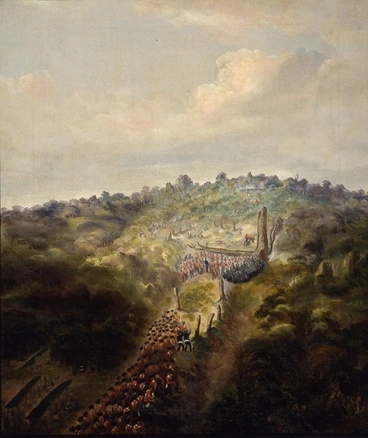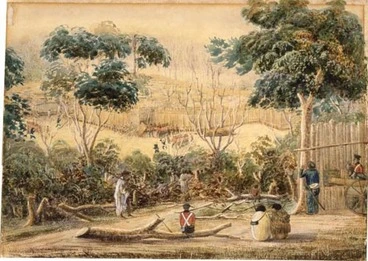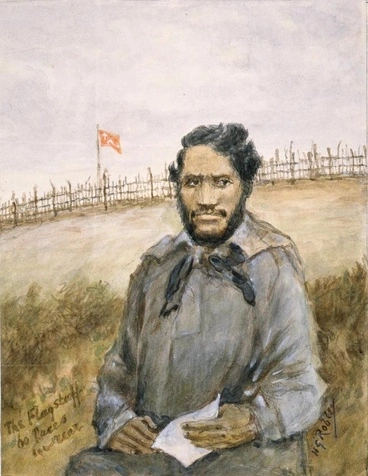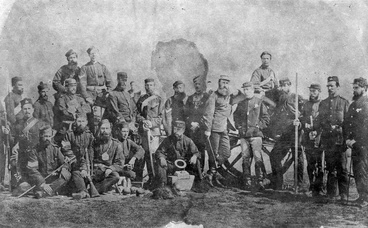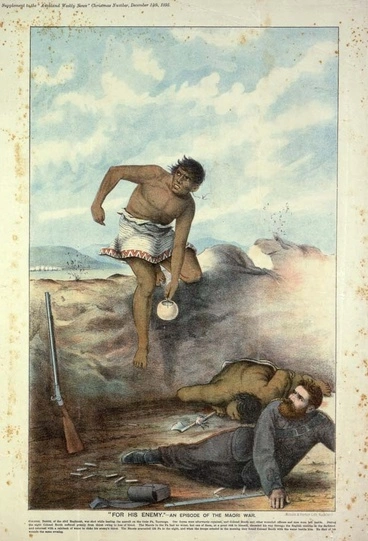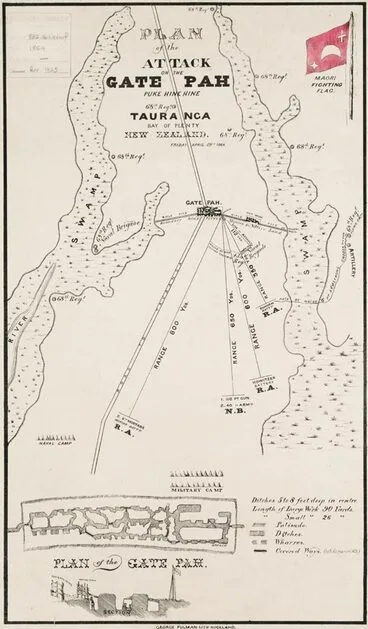War in Tauranga 1864
A DigitalNZ Story by National Library of New Zealand Topics
The New Zealand Wars | Ngā Pakanga o Aotearoa campaign in Tauranga is best known for the notable British Army loss at Gate Pa. However, this victory for local Ngāi Te Rangi was short-lived and confiscation of their whenua proceeded after their significant defeat at Te Ranga and the loss of their leader, Rāwiri Puhirake. SCIS no. 1966017
social_sciences, arts, english, history, health, Māori, technology
IMG_7778
Manatū Taonga, the Ministry for Culture and Heritage
Gate Pa, Tauranga.
Museum of New Zealand Te Papa Tongarewa
War in Tauranga - War in Tauranga
Manatū Taonga, the Ministry for Culture and Heritage
The Battle of Gate Pa
Services to Schools
Scene in the pits, Gate Pah
Museum of New Zealand Te Papa Tongarewa
The Potiriwhi, Code of Conduct
Services to Schools
Pukehinahina,Gate Pā: A personal Māori perspective
Services to Schools
Monument to Rāwiri Puhirake
Manatū Taonga, the Ministry for Culture and Heritage
Buddy Mikaere on the Battle of Gate Pā
Services to Schools
150 years since the Battle of Te Ranga
Services to Schools
Surrender of the Tauranga natives at Te Papa.
Museum of New Zealand Te Papa Tongarewa
Te Ranga NZ Wars memorial
Manatū Taonga, the Ministry for Culture and Heritage
Battle of Te Ranga
Manatū Taonga, the Ministry for Culture and Heritage
Te Ranga battle site, Tauranga
Archives New Zealand Te Rua Mahara o te Kāwanatanga
IMG_5727
Manatū Taonga, the Ministry for Culture and Heritage
IMG_5632
Manatū Taonga, the Ministry for Culture and Heritage
IMG_5729
Manatū Taonga, the Ministry for Culture and Heritage
"Te Harawera Tauranga"
Puke Ariki
Tauranga naval NZ Wars memorial
Manatū Taonga, the Ministry for Culture and Heritage
Camp Te Papa, Tauranga.
University of Otago
Tauranga in 1864
Manatū Taonga, the Ministry for Culture and Heritage
Officers' mess hut, Tauranga
Alexander Turnbull Library
Pene Taka Tuaia
Manatū Taonga, the Ministry for Culture and Heritage
THE WAR AT TAURANGA. (FROM OUR OWN CORRESPONDENT.) February 5. (Daily Southern Cross, 01 March 1867)
National Library of New Zealand
Hēnare Taratoa and the Code of Conduct
“On taking possession (of the pa), Lieutenant-Colonel Booth and some men were found still living, and, to the credit of the native, had not been maltreated; nor had any of the bodies of the killed been mutilated.” Dispatch by Lt-General Cameron to Sir George Grey. It was the preacher and teacher, Hēnare Taratoa who formulated a code of conduct that set out the behaviour for Māori fighting at Gate Pā in 1864. For example Rule 1 read that: If wounded or (captured) whole, and butt of the musket or hilt of the sword be turned to me (he) (British soldier) will be saved. True to their word, the night after the battle some Māori fighters tended to the wounded British troops left behind in Gate Pā.
Alexander Turnbull Library
The aftermath of Gate Pa and Te Ranga battles
Low-level warfare continued after battles at Gate Pa and Te Ranga, as British troops and kaupapa destroyed local Māori papa kainga and crops. Raupatu was severe. Eventually, almost 300,000 acres of land was confiscated from Tauranga Moana mainly from iwi who fought at Gate Pā and Te Ranga. Today Ngāi Te Rangi retains just 2 percent of their original rohe.
Museum of New Zealand Te Papa Tongarewa
Gate Pā
Manatū Taonga, the Ministry for Culture and Heritage
Redoubt built on the site of Gate Pa
Museum of New Zealand Te Papa Tongarewa
Robley, Horatio Gordon 1840-1930 :Taratoa, lay preacher. Killed at Te Ranga, 21st June 1864.
Alexander Turnbull Library
Surviving Gate Pa
Just what was it like to be under a British bombardment? Heni Pore who survived the battle of Gate Pā recounts that Māori in Gate Pā were holding a religious service and were on the last blessing when the first shell fell around daybreak. It didn’t fall on the service instead she said it went “right into our hangi…and the next moment we saw the potatoes we had scrapped flying high in the air, all over the place.”
Services to Schools
Troops depart for Tauranga
William Fox, Colonial Secretary and Native Affairs Minister, ordered British troops to Tauranga in early 1864. Endorsed and actioned by General Cameron, the reasoning was that this would stop any reinforcements and logistics from Tauranga Moana iwi reaching Kingitanga in the Waikato who were then fighting British troops. For local Māori the arrival of troops was justifiably unreasonable, (especially when the harbour was blockaded, and British troops constructed 2 redoubts) and they began to prepare for the inevitable conflict. Apart from the battle at Matatā, the first major engagement was at Pukehinahina (Gate Pā) followed by the equally disastrous (for Ngāi Te Rangi) Te Ranga battle.
University of Otago
The attack on Gate Pā
Services to Schools
The Tauranga Campaign
Services to Schools
The story of Gate Pā 1864
Services to Schools
Traces of Pukehinahina
Services to Schools
Battle of Gate Pa remembered 150 years on
Services to Schools
The Tauranga Bush Campaign
Services to Schools
General Cameron’s official account of the attack on Tauranga Pā
Services to Schools
Traces of Pukehinahina
Services to Schools
The Tauranga Campaign
Services to Schools
Battle of Gate Pā
Services to Schools
The Tauranga battles of Gate Pā (Pukehinahina) and Te Ranga
Services to Schools
The Tauranga War
Services to Schools
Captain John Charles Hamilton
Mid 1864, a reporter from the New Zealander visited the graveyard at Te Papa, Tauranga. He commented on the graves, of British troops who had fallen at the Battle of Gate Pā. In describing one in particular the reporter noted that the officer had “sprung upon the parapet on reaching the Pā, shouting, “ Follow me, men!” and was promptly shot through the head. This was Captain John Charles Hamilton, naval commander of the Esk, one of many officers who died at the Battle of Gate Pā. In fact, of the nine British officers that attended a dinner the night before the battle only one survived. The city Hamilton was named after Captain John Charles Hamilton despite the fact he never visited it.
Museum of New Zealand Te Papa Tongarewa
Gate Pa: Lest we forget
Services to Schools
Plan of Gate Pā
Manatū Taonga, the Ministry for Culture and Heritage
Robley, Horatio Gordon 1840-1930 :Surrender of the Ngaiterangi at Te Papa - coming in with arms
Alexander Turnbull Library
Gate Pa battle
As planned Māori fighters at Gate Pa held their fire (so that British troops would think the Pā deserted or that Māori had mostly been killed in the bombardment.) They waited in silence until the soldiers were in close range then Rawiri gave the order ‘Puhia!’ (fire!) After that there was furious and terrible hand-to-hand combat fighting. Māori fighters fired their muskets and shotguns, then used their tomahawks, mere, or the butt ends of their guns to drive back the British troops. Within ten minutes the British assault party suffered 100 casualties. Then they fled.
Manatū Taonga, the Ministry for Culture and Heritage
The story of Te Kooti 1868-73
DigitalNZ
War in the Waikato 1863-65
DigitalNZ
The Story of Rua Kēnana, 1916
DigitalNZ
Hēnare Taratoa
Manatū Taonga, the Ministry for Culture and Heritage
General Cameron at Gate Pā
Manatū Taonga, the Ministry for Culture and Heritage
Lieutenant-Colonel Booth at Gate Pā
Manatū Taonga, the Ministry for Culture and Heritage
Horatio Gordon Robley: Paintings from the War in Tauranga (1864)
Services to Schools
Plan of attack on Gate Pā
Manatū Taonga, the Ministry for Culture and Heritage
Breach at Gate Pa, morning of April 30, 1864
Museum of New Zealand Te Papa Tongarewa
The battles of Gate Pā (Pukehinahina) & Te Ranga
Services to Schools
